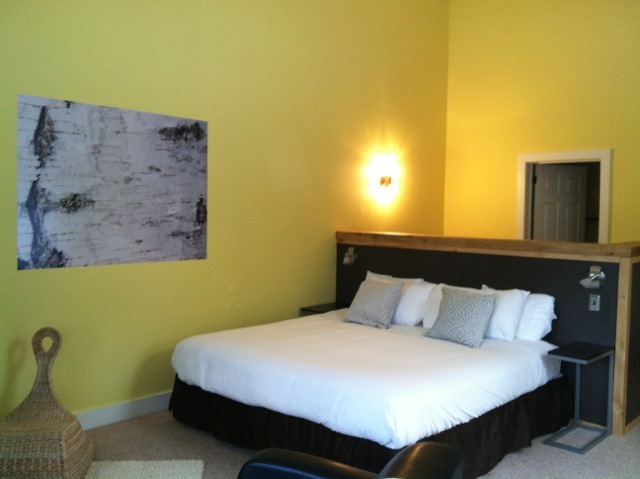Musee de la Civilisation A Must-Stop in Quebec City
Quebec City’s Musee de la Civilisation might sound like some vague museum of anthropology. Venture inside and you’ll be surprised to find one of the most intriguing museums in North America. On my last trip to Quebec City, I was treated to an exhibition called Urbanopolis, an architectural study that shows how cities around the world are preparing themselves for the future through apartment design and public transportation. When I returned this weekend, I saw a fascinating show on Nigerian art from private French collections, rarely seen by the public. The 187 objects from 44 various ethnic groups in Nigeria included a series of large masks created from, among other things, the human skull, facial hair, antelope horns, and lion’s teeth. I especially enjoyed the films of anthropologist Arnold Rubin from the 1960s that showed remote Nigerian tribesmen dancing with several of the masks and costumes on display. Another worthwhile exhibition at the Museum showcased New Zealand’s Maori culture and featured large wooden carvings from ancestral meeting houses.
Time to Party With Bonhomme at Winter Carnival
 If you love Paris in the springtime, then you’ll adore Quebec City in the wintertime, where, for 17 days, the party never stops. Quebec City’s Winter Carnival is the largest in the world, attracting more than one million people. I was one of those fortunate people to arrive in this fortified city on the first day of the 2013 Winter Carnival. I spent the morning sledding down an ice chute, viewing the impressive ice castle, made from 1600 blocks of ice, eating maple syrup on snow, and playing a human game of foosball. Attached to bars with seatbelts, you slide all over the ice trying to kick the ball into the goal. But the party really started on Saturday night, when top DJs from Montreal and Toronto played a mesmerizing mix of hip-hop and electronica to a crowd of revelers outside the ice castle. Locals carry cane-like red sticks filled with a potent drink called Caribou, made of whiskey, red wine, and maple syrup, which certainly added to the dancing frenzy. When Bonhomme, the popular snowman and revered host of the festivities started to boogie, the crowd went wild.
If you love Paris in the springtime, then you’ll adore Quebec City in the wintertime, where, for 17 days, the party never stops. Quebec City’s Winter Carnival is the largest in the world, attracting more than one million people. I was one of those fortunate people to arrive in this fortified city on the first day of the 2013 Winter Carnival. I spent the morning sledding down an ice chute, viewing the impressive ice castle, made from 1600 blocks of ice, eating maple syrup on snow, and playing a human game of foosball. Attached to bars with seatbelts, you slide all over the ice trying to kick the ball into the goal. But the party really started on Saturday night, when top DJs from Montreal and Toronto played a mesmerizing mix of hip-hop and electronica to a crowd of revelers outside the ice castle. Locals carry cane-like red sticks filled with a potent drink called Caribou, made of whiskey, red wine, and maple syrup, which certainly added to the dancing frenzy. When Bonhomme, the popular snowman and revered host of the festivities started to boogie, the crowd went wild.Modernism Comes to the Portland Museum of Art This Summer
William S. Paley (1901–1990), the media titan who built the CBS broadcasting empire, amassed an extraordinary collection of modern art. He also became the catalytic force behind The Museum of Modern Art (MoMA), which opened in 1929. When he died, he donated his entire collection to MoMA. Now MoMA is sharing 62 of those treasures with other art museums. The William S. Paley Collection: A Taste for Modernism, will be on view May 2 through September 8, 2013, at the Portland Museum of Art. Edgar Degas, Paul Cézanne, Paul Gauguin, Pablo Picasso, Henri Matisse, Joan Miró, Alberto Giacometti, and Francis Bacon, are among the 24 artists whose paintings, sculpture, and works on paper will grace the walls. The Portland Museum of Art is the only New England venue for this blockbuster show, which will then move on to Quebec City.
Newly Renovated Ten Acres Lodge Offers Affordable Lodging in Stowe
 Perched on a quiet hillside just down the road from Trapp Family Lodge, Ten Acres Lodge always had a fabulous spot in Stowe. Now they have a passionate owner to match their stellar locale. Linda Hunter has quickly made a name for herself in town, opening a bistro that’s winning kudos from locals like Vermont PR maven, Emily Bradbury. Now Hunter has her sites set on the rooms, renovating tired interiors into stylish and comfortable getaways. She’s having a soft opening right now. Tell her I sent you.
Perched on a quiet hillside just down the road from Trapp Family Lodge, Ten Acres Lodge always had a fabulous spot in Stowe. Now they have a passionate owner to match their stellar locale. Linda Hunter has quickly made a name for herself in town, opening a bistro that’s winning kudos from locals like Vermont PR maven, Emily Bradbury. Now Hunter has her sites set on the rooms, renovating tired interiors into stylish and comfortable getaways. She’s having a soft opening right now. Tell her I sent you.
Liftopia Offering Discounted Lift Tickets for Super Bowl Sunday
Liftopia, the largest online marketplace for discounted lift tickets, is launching its biggest sale of the year today. Grab savings of up to 70% off lift tickets at more than 200 ski resorts for Super Bowl Sunday. With the game starting at 6:30 pm EST, you have plenty of time to hit the slopes before the game. In Vermont, lift tickets at Bolton Valley start at $10, Jay Peak at $46, Okemo at $59, and Stratton at $60. New Hampshire’s Ragged Mountain will be offering lift tickets for $27. In Utah, the Canyons has lift tickets for $69 and Solitude is offering tickets for $50. In Colorado, ski Copper for $55. The list goes on and on!
Larry Meehan, In Memoriam
“Steve, do you realize we’re standing at the junction of King and Queen Streets?” Larry Meehan asked in his typical animated tone. “No, Larry. Actually, I thought we were dining at a seafood restaurant,” I muttered. “This is the heart of Colonial Boston,” he would say to me, even more passionate. “Where it all happened!” Every conversation I had with Larry Meehan was peppered with some historical tidbit about his beloved city. Sure, he often spoke about the success of his wife and boys, biking around Martha’s Vineyard the week after Labor Day, when most of the crowds were gone, all the new hotels and restaurants that were popping up all over the city. And he couldn’t resist teasing me about my next Sabena Belgium assignment. One of the first stories I ever wrote was on a store in Faneuil Hall that sold detritus from the city, like seats from the old Boston Garden or a century-old street lamppost. “Is this for Sabena magazine?” he would say with a smile years later, referring to the now defunct inflight magazine.
